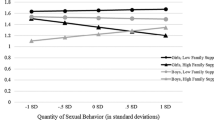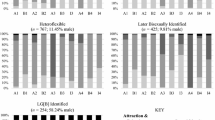Abstract
Dating in adolescence plays an integral part in the development of sexual and social identities. This process is particularly salient for sexual minority youth who face additional obstacles to their identity formation due to their marginalized status. We investigated the influence of participating in a same-sex relationship (SSR) or an opposite-sex relationship (OSR) on sexual minority youths’ psychological well-being (i.e., symptoms of depression, anxiety and internalized homophobia, and self-esteem) in an ethnically-diverse sample of 350 youth (55% male) between the ages of 15–19 years, recruited from three GLBT drop-in centers in the New York City area. Using longitudinal data, we examined youths’ SSR and OSR over time. Multivariate regression analyses suggest that involvement in a SSR was positively associated with changes in self-esteem in males, and negatively correlated with changes in internalized homophobia in females. We discuss the implications for positive development in sexual minority adolescent populations.
Similar content being viewed by others
References
Bauermeister, J. A., Morales, M., Seda, G., & González-Rivera, M. (2008). Sexual prejudice among puerto rican young adults. Journal of Homosexuality, 53(4), 135–161.
Bauermeister, J. A., Zimmerman, M. A., Caldwell, C. H., Xue, Y., & Gee, G. C. (2009). What predicts sex partners’ age differences among african american youth? A longitudinal study from adolescence to young adulthood. Journal of Sex Research, 46, 1–15.
Beck, A. T. (1996). Beck depression inventory II. San Antonio, TX: Psychological Corporation.
Binson, D., Blair, J., Huebner, D. M., & Woods, W. J. (2007). Sampling in surveys of lesbian, gay, and bisexual people. In I. H. Meyer & M. E. Northridge (Eds.), The health of sexual minorities: Public health perspectives on lesbian, gay, bisexual and transgender populations (pp. 375–418). New York, NY: Springer.
Bos, H. M. W., Sandfort, T. G. M., Bruyn, E. H., & Hakvoort, E. M. (2008). Same-Sex attraction, social relationships, psychosocial functioning, and school performance in early adolescence. Developmental Psychology, 44(1), 59–68.
Bouchey, H. A., & Furman, W. (2003). Dating and romantic experiences in adolescence. In G. R. Adams & M. Berzonsky (Eds.), The blackwell handbook of adolescence (pp. 239–313). Oxford, UK: Blackwell Publishers.
Coleman, E. (1987). Assessment of sexual orientation. Journal of Homosexuality, 14(1), 9–24.
Connolly, J., Furman, W., & Konarski, R. (2000). The role of peers in the emergence of heterosexual romantic relationships in adolescence. Child Development, 71(5), 1395–1408.
D’Augelli, A. R. (2002). Mental health problems among lesbian, gay, and bisexual youths ages 14–21. Clinical Child Psychology and Psychiatry, 7(3), 439–462.
D’Augelli, A. R., & Grossman, A. H. (2006). Researching lesbian, gay, and bisexual youth: Conceptual, practical, and ethical considerations. Journal of Gay and Lesbian Issues In Education, 3(2/3), 35–56.
Davila, J., Steinberg, S. J., Kachadourian, L., Cobb, R., & Fincham, F. (2004). Romantic involvement and depressive symptoms in early and late adolescence: The role of preoccupied relational style. Personal Relationships, 11, 161–178.
Derogatis, L. R. (1993). The brief symptom inventory: Administration, scoring, and procedures manual. Minneapolis, MN: National Computer Systems.
Detrie, P. M., & Lease, S. H. (2007). The relation of social support, connectedness, and collective self-esteem to the psychological well-being of lesbian, gay, and bisexual youth. Journal of Homosexuality, 53(4), 173–199.
Diamond, L. M., & Savin-Williams, R. C. (2003). Explaining diversity in the development of same-sex sexuality among young women. In L. D. Garnets & D. C. Kimmel (Eds.), Psychological perspectives on lesbian, gay, and bisexual experiences (pp. 130–148). NY: Columbia University Press.
Diamond, L. M. & Savin-Williams, R. C. (in press). Same-sex activity in adolescence: Multiple meanings and implications. In S. Morrow & R. Fassinger (Eds.) Sex in the margins: Erotic lives of lesbian, gay, and bisexual people. Washington, D.C.: American Psychological Association.
Diamond, L. M., Savin-Williams, R. C., & Dubé, E. M. (1999). Sex, dating, passionate friendships, and romance: Intimate peer relations among lesbian, gay, and bisexual adolescents. In W. Furman, B. B. Brown, & C. Feiring (Eds.), The development of romantic relationships in adolescence (pp. 175–210). New York: Cambridge University Press.
Ford, K., & Lepkowski, J. M. (2004). Characteristics of sexual partners and STD infection among American adolescents. International Journal of STD and AIDS, 15, 260–265.
Furman, W., & Shaffer, L. (2003). The role of romantic relationships in adolescent development. In P. Florsheim (Ed.), Adolescent romantic relations and sexual behavior: Theory, research, and practical implications (pp. 3–22). Mahwah, NJ: Erlbaum.
Galambos, N. L., Almeida, D. M., & Petersen, A. C. (1990). Masculinity, femininity, and sex role attitudes in early adolescence: Exploring gender intensification. Child Development, 61(6), 1905–1914.
Galambos, N. L., Barker, E. T., & Krahn, H. J. (2006). Depression, self-esteem, and anger in emerging adulthood: Seven-year trajectories. Developmental Psychology, 42(2), 350–365.
Garofalo, R., Wolf, R. C., Kessel, S., Palfrey, J., & DuRant, R. H. (1998). The association between health risk behaviors and sexual orientation among a school-based sample of adolescents. Pediatrics, 101, 895–902.
Glover, J. A., Galliher, R. V., & Lamere, T. G. (2009). Identity development and exploration among sexual minority adolescents: Examination of a multidimensional model. Journal of Homosexuality, 56, 77–101.
Goodenow, C., Szalacha, L., & Westheimer, K. (2006). School support groups, other school factors, and the safety of sexual minority adolescents. Psychology in the Schools, 43(5), 573–589.
Graber, J. A., & Archibald, A. B. (2001). Psychosocial change at puberty and beyond: Understanding adolescent sexuality and sexual orientation. In A. R. D’Augelli & C. J. Patterson (Eds.), Lesbian, gay, and bisexual identities and youth: Psychological perspectives (pp. 3–26). New York, NY: Oxford University.
Herek, G., & Capitano, J. P. (1999). AIDS stigma and sexual prejudice. The American Behavioral Scientist, 42, 1130–1147.
Igartua, K. J., Gill, K., & Montoroyr, R. (2003). Internalized homophobia: A factor in depression, anxiety, and suicide in the gay and lesbian population. Canadian Journal of Community Mental Health, 22(2), 15–30.
Isay, I. (2009). Becoming gay: The journey to self-acceptance. New York, NY: Vintage Books.
Kinsey, A. C., Pomeroy, W. B., & Martin, C. E. (1948). Sexual behavior in the human male. Philadelphia: W.B. Saunders.
La Greca, A. M., & Harrison, H. M. (2005). Adolescent peer relations, friendships, and romantic relationships: Do they predict social anxiety and depression? Journal of Clinical Child & Adolescent Psychology, 34(1), 49–61.
Mays, V. M., & Cochran, S. D. (2001). Mental health correlates of perceived discrimination among lesbian, gay, and bisexual adults in the united states. American Journal of Public Health, 91(11), 1869–1876.
Meyer, I. H. (2003). Prejudice, social stress, and mental health in lesbian, gay, and bisexual populations: Conceptual issues and research evidence. Psychological Bulletin, 129(5), 674–697.
Meyer, I. H., Dietrich, J., & Schwartz, S. (2007). Lifetime prevalence of mental disorders and suicide attempts in diverse lesbian, gay, and bisexual populations. American Journal of Public Health, 97(11), 8–11.
Peplau, A. L., & Fingerhut, A. W. (2007). The close relationships of lesbians and gay men. Annual Review of Psychology, 58, 405–424.
Rivers, I., & D’Augelli, A. R. (2001). The victimization of lesbian, gay, and bisexual youths. In A. R. D’Augelli & C. J. Patterson (Eds.), Lesbian, gay, and bisexual identities and youth: Psychological perspectives (pp. 199–223). New York, NY: Oxford University.
Rosenberg, M. (1979). Conceiving the self. NY: Basic Books.
Russell, S. T., & Consolacion, T. B. (2003). Adolescent romance and emotional health in the united states: Beyond binaries. Journal of Clinical Child and Adolescent Psychology, 32(4), 499–508.
Schneider, M. S. (2001). Toward a reconceptualization of the coming-out process for adolescent females. In A. R. D’Augelli & C. J. Patterson (Eds.), Lesbian, gay, and bisexual identities and youth: Psychological perspectives (pp. 71–96). NY: Oxford University.
Shidlo, A. (1994). Internalized homophobia: Conceptual and empirical issues in measurement. In B. F. Greene & G. Herek (Eds.), Lesbian and gay psychology: Theory, research and clinical applications (pp. 176–205). Thousand Oaks, CA: Sage.
Szymanski, D. M., Chung, Y. B., & Balsam, K. F. (2001). Psychosocial correlates of internalized homophobia in lesbians. Measurement and Evaluation in Counseling and Development, 34(1), 27–38.
Tolman, D. L. (2006). In a different position: Conceptualizing female adolescent sexuality development within compulsory heterosexuality. New Directions in Child and Adolescent Development, Summer(112), 71–89.
Tolman, D. L., Striepe, M. I., & Harmon, T. (2003). Gender matters: Constructing a model of adolescent sexual health. The Journal of Sex Research, 40(1), 4–12.
Wingood, G. M., & DiClemente, R. J. (2002). The theory of gender and power: A social structural theory for guiding public health interventions. In R. J. DiClemente, R. A. Crosby, & M. C. Kegler (Eds.), Emerging theories in health promotion practice and research (pp. 313–346). San Francisco: Jossey-Bass.
Zimet, G. D., Dahlem, N. W., Zimet, S. G., & Farley, G. K. (1988). The multidimensional scale of perceived social support. Journal of Personality Assessment, 52, 30–41.
Acknowledgments
Data for this project was collected as part of a five-year National Institute of Mental Health grant, RO1-MH058155 (“Victimization and Mental Health among High Risk Youths”), awarded to Drs. Anthony R. D’Augelli and Arnold H. Grossman.
Author information
Authors and Affiliations
Corresponding author
Rights and permissions
About this article
Cite this article
Bauermeister, J.A., Johns, M.M., Sandfort, T.G.M. et al. Relationship Trajectories and Psychological Well-Being Among Sexual Minority Youth. J Youth Adolescence 39, 1148–1163 (2010). https://doi.org/10.1007/s10964-010-9557-y
Received:
Accepted:
Published:
Issue Date:
DOI: https://doi.org/10.1007/s10964-010-9557-y




